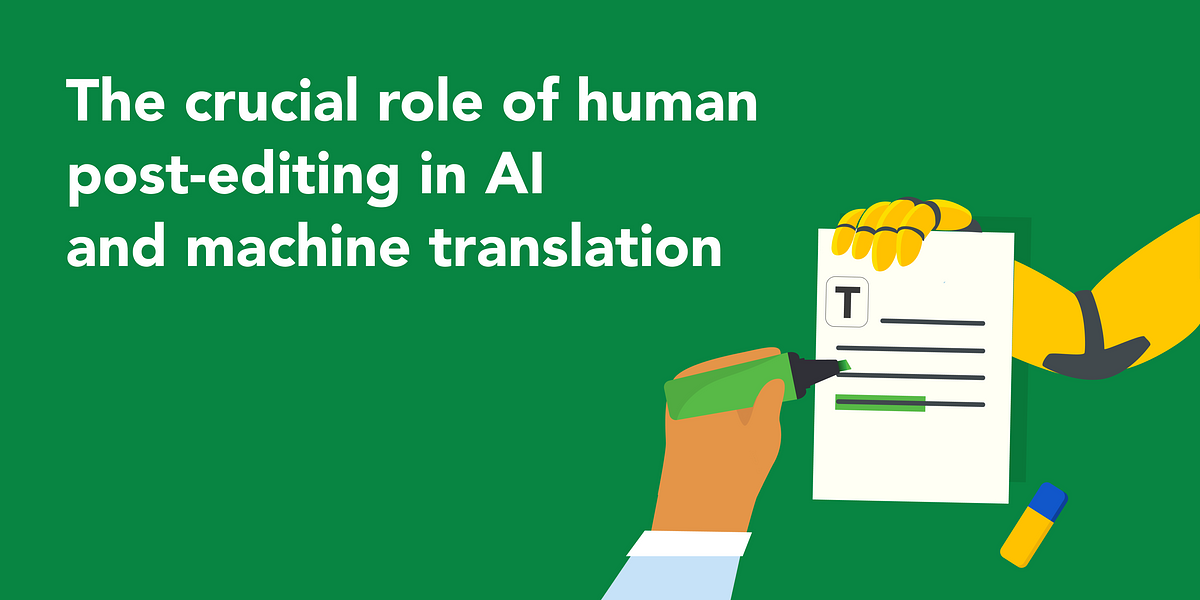
The crucial role of human post-editing in AI and machine translation
Artificial intelligence is huge now. The allure is clear—it offers a fast and cost-effective way to translate large volumes of content into multiple languages. However, whilst the technology has made significant strides in recent years, it is by no means a silver bullet solution. Relying solely on raw AI output without human post-editing can lead to poor localisation, which is very likely to damage a company's reputation and bottom line.
In this article, we'll take a closer look at the current state of artificial intelligence, the risks businesses face when they treat it as a complete localisation solution, and the crucial role of human post-editing.
AI is awesome, but...
Artificial intelligence is undeniably transforming translation—breaking down language barriers at an unprecedented scale and speed. However, leveraging AI as a sole solution introduces a broad spectrum of issues that are essential to address for effective communication.
While neural translation tools, including machine translation (MT), have made remarkable advances, they are not yet capable of comprehending the full context and nuanced meanings inherent in human languages. Idiomatic expressions, humour, sarcasm, and subtle shades of meaning can get lost in translation, leading to overly literal outputs or significant gaps in conveying the intended message.
AI models often struggle with unconventional vocabulary, jargon, or technical terms, posing risks for critical mistranslations in sensitive areas such as law, medicine, or engineering.
One significant limitation is the difficulty AI faces in localising content for specific target audiences. Unlike human translators, who not only translate but also adapt the material to fit cultural contexts and audience preferences, AI tools lack this cultural intelligence. This often results in translations that may not resonate effectively with target demographics.
Not all languages are the same
It’s also important to underline that aside from struggling with nuance, context, and cultural appropriateness, several reports on the state of AI suggest that few vendors currently deliver top-level quality for challenging languages like Arabic, Japanese, and Ukrainian.
These are but a few languages that pose unique difficulties for neural systems due to factors like complex grammar structures, lack of large bilingual training data, and significant linguistic differences from English and other high-resource languages.
Arabic, for instance, has highly intricate morphology and dialect variations that make building accurate AI models an ongoing challenge. Japanese relies heavily on context and has a unique writing system that mixes multiple scripts. Ukrainian, as a less widely spoken language, needs more parallel corpora to train high-performing neural MT engines. And there are dozens of other widely spoken languages that can be problematic for machine translation tech.
As a result, even the most advanced systems today still struggle to achieve human parity when translating these languages, emphasising the continued need for human involvement and post-editing to ensure top-quality translations. Businesses should carefully evaluate MT vendor performance for their specific language needs and consider language-specific customisation to optimise results.
The risks of poor localisation for businesses
The stakes in getting localisation right are high. Mistranslations and culturally-insensitive content can seriously damage a company's credibility and reputation with international audiences. For important business, legal or technical documents, translation errors can lead to costly miscommunication and even legal issues.
With the global AI market estimated to be valued at a staggering $184 billion in 2024, an increasing number of companies are investing in these technologies. But those who treat it as a complete localisation solution on its own are setting themselves up for problems.
Inaccurate translations can land businesses in legal trouble abroad. Mistranslated labels, instructions or contracts may violate local compliance requirements. In sensitive domains like healthcare, incorrect translations can even jeopardise patient safety, as seen in the case of 47 botched knee surgeries in Germany due to a prosthetic labelling error.
Companies that translate effectively are better positioned to capture market share in new regions. Poorly localised user experiences drive customers to competitors' offerings that feel more in-tune with local preferences. Subpar translations also delay entry into high-potential markets, with opportunity costs mounting as rivals gain a foothold.
Leverage AI strategically with post editing
At Wordminds, we strongly believe that AI translation can be a powerful tool for businesses to scale their localisation efforts and engage global audiences. However, our experience and industry best practices clearly show that AI should not be treated as a complete solution on its own. To ensure high translation quality that resonates with local markets, MT and AI must be strategically combined with human post-editing.
We recommend businesses adopt the following approach to get the most value:
- Use AI selectively: Evaluate which content types are most suitable for machine translation based on the required quality level, turnaround time, and available resources for post-editing. User-facing marketing content may need more intensive MTPE, whilst high-volume technical documentation could rely more heavily on neural engines.
- Choose the right AI engine: Not all models perform equally for all language pairs and domains. Assess generic and custom options and select the best-performing engine for your content needs. Consider building a custom engine trained on your company's bilingual data for even better results.
- Invest in professional post-editing: Engage skilled linguists with subject matter expertise to review and refine the AI output. Provide them with clear guidelines on the required quality level (e.g. light vs. full post-editing) and reference materials like style guides and glossaries to aid their work.
- Integrate human post-editing into your workflow with quality checks at crucial points: Collaborate with your localisation partner or use your own validators to ensure accuracy. Track metrics to optimise the process and maintain high-quality translations.
The bottom line
Machine translation and AI have undoubtedly made significant advancements in recent years, offering businesses a fast and cost-effective way to translate large volumes of content into multiple languages. However, it is crucial to recognise that these technologies are not complete solutions for high-quality localisation. Relying solely on raw MT or AI output without human post-editing can lead to poor translations that damage a company's reputation and bottom line.
To mitigate the risks of poor localisation, businesses must leverage MT strategically by combining it with professional machine translation post-editing (MTPE). This approach involves selectively using MT based on content type and required quality level, choosing the right MT engine for specific language pairs and domains, investing in skilled linguists for post-editing, implementing a robust localisation workflow, and collaborating closely with stakeholders.
About Wordminds
Wordminds is a close-knit team of language experts – professional translators, project managers, localisation engineers and business visionaries who work closely with global clients, helping them connect with their international audience. Wordminds works with over 3,000 language specialists and subject-matter experts to enable companies to overcome cultural and language barriers, helping them build trust and create long-lasting business and human relationships. Fully certified under ISO 9001, ISO 17100, and ISO 27001 the company believes in continuous improvement and so stands at the forefront of new language-technology implementation, smart collaboration and excellent customer service. Find out more about Wordminds.
Join our Newsletter
Stay up to date with the latest articles, news and translation insights


